
"Email marketing is still the #1 best way to engage with your audience and convert leads into customers — but if no one is opening your emails, you've got a problem."
Alex Cattoni, Founder of The Copy Posse
Take it from the expert. Your subject line can single-handedly make or break your entire email campaign.
That's why we put together this list of best practices to help you create attention-grabbing subject lines for your email marketing campaigns.
In fact, 47% of email recipients admit to opening email based on the subject line alone.
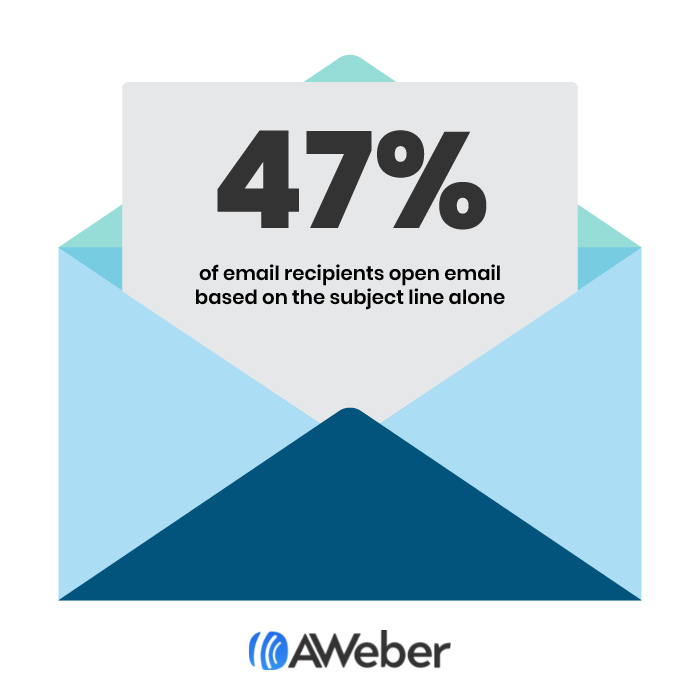
One of the most common questions we hear is: “what do I write in the subject line of an email?” Many people wonder how to write perfect email subject lines.
That’s why we put together this list of subject line best practices to help you create attention-grabbing emails.
Email subject line best practices
- Personalize your email subject lines
- Use segmentation
- Create urgency with FOMO
- Avoid spam triggers
- Be direct
- Ask questions
- Use numbers
- Try a subject line generator
- One word subject lines
- Super long subject lines
- Understand your audiences' pain points
- Get personal
- Provoke emotion
- AB split test your subject line
14 email subject line best practices
1 - Personalize your email subject lines
Do any of these subject lines catch your attention?

Not particularly.
Many years ago when companies first started using first name personalization, it worked. It grabbed your attention. But now, variations of “Hello {!firstname_fix}” have become the norm in email marketing, not the outlier. Because of that, it’s lost its novelty.
But that’s not the type of personalized email subject line I’m talking about. To truly create an email subject line that gets attention, you need to make the content unique to that individual subscriber.
You need to go above and beyond to connect with each customer. You can do this by personalizing your message based on location, past purchase behavior, and content they’ve engaged with. Think of what information you have on your customers. Now use that to create a personalized experience for them.
What if I took the same email blast subject lines examples above, but made them personalized based on my experiences with those brands?

Now that made a difference.
So what’s the best way to accomplish this? With your next email subject line best practice - segmentation.
2 - Use segmentation
At AWeber, we recommend segmenting your audience and sending each segment tailored messages with unique subject lines.
Joanna Wiebe, Founder of Copyhackers, agrees: "The #1 thing we continue to find is that opens skyrocket when your subject line is specific to the segmented list you're sending to."
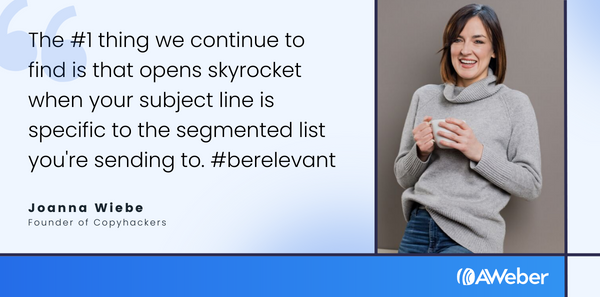
Here are some ways to do just that:
- Ask questions on your sign up form.
Then use that information in your email subject lines. For example, if you write a fashion blog, you can ask your subscriber for his or her favorite color when they sign up to your mailing list. Then, you can send them emails based on their color choice — like “15 gorgeous [color] dresses under $50.” - Send location-based emails.
Traveling to a conference? Speaking at an event? Meet up with your subscribers in different cities. “We’re in [city] next week! See you there?” - Retarget subscribers.
Did a subscriber abandon a product in his or her shopping cart? You could send an email like “Forget something? Here’s a 20% off coupon!” Or did a subscriber not follow through on an action, like registering for your webinar or workshop? Use that info to tailor their next message. “Only 12 hours to sign up for [event]!”
3 - Create urgency in your subject line with FOMO
Fear of missing out — or FOMO — is a powerful psychological driver of email opens and engagement. Email subject lines that create a sense of urgency, scarcity, and exclusivity can boast a 22% higher open rate.
This can be done by giving your subscribers a deadline to accomplish an action.
Here are some other effective FOMO email subject line examples:
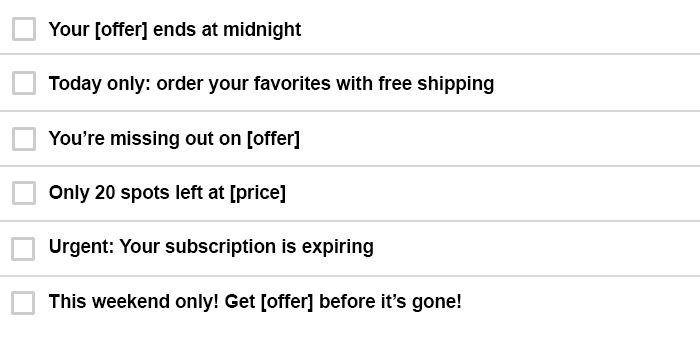
4 - Avoid spam triggers in your subject line
Email spam filters are triggered by specific words, phrases, and symbols in your subject line and email content.
So what are some words, phrases, and symbols that are red flags to spam filters? There are a ton, but here’s a few to give you an example:
- Excessive punctuation like multiple exclamation points!!!!!!! or ellipses ………
- TYPING IN ALL CAPS
- Symbols like “$$$” and “*****”
- Phrases like “cheap,” “cash off,” “incredible deal,” “satisfaction,” “winner”
Also, as many as 69% of email recipients report email as spam based solely on the subject line. Make sure your subject line doesn’t come across as spammy to your subscriber, too. This will happen if your subject line is deceiving in any way, such as leading with “RE:” when it’s not an actual reply to an email.
5 - Be direct in your subject line
Skip the wit, wordplay, humor, rhymes, or puns in your subject lines.
Stick with straightforward headlines instead. These “boring” subject lines convert extremely well. That’s because they explain the value inside the email. The readers know exactly what to expect from the message and the benefits they’ll receive from opening it.
Here are some straightforward email subject line examples:

But there’s one catch: Your messages have to consistently provide value. If your messages fall short of their promised value, your subscribers will feel cheated. Then, good luck getting them to open your messages moving forward.
However, if your emails are constantly packed with important, personalized content, your audience will open your emails — no matter what the subject line says.
6 - Ask questions to pique curiosity
There’s a reason most television season finales end with cliffhangers: Humans crave nice-and-neat endings. So when you don’t give it to them, they’re unsettled. They have to know what happens next, and they’ll tune in the next season for closure.
Use this craving to your advantage. Fuel your subscribers to open your emails by injecting curiosity into your subject lines. You can ask a question:
- Jo at Copy Hackers: “Are you missing these 3 copy techniques?”
- Men’s Health Daily Dose: “Will Creatine Boost Your Gains?”
Or promise an answer inside your message:
- Jessica Stansberry: “You should be going live ___ times per month! [open for the answer]”
- Sophie Gray: “This is the ONLY Reason You Should Workout”
Or tease a surprise, giveaway, or gift:
- AWeber Blog: “We made free Fall GIFs for you!”
Or make readers say “huh?!”
- Chubbies: “Sincerely, future Dwight”
- Really Good Emails: “Emails can be tasty"
7 - Use numbers
Using numbers in your subject line is a great way to grab your reader's attention. Plus numbers add authority and lend weight to your subject line. See for yourself, which of these subject lines would you open:
The key to writing great subject lines
or
10 keys to writing great subject lines
Adding the number to the subject line leads your customer to assume they will learn more from your email.
The proof is in the data. Yesware analyzed over 100 million emails and found those with numbers received a higher open.
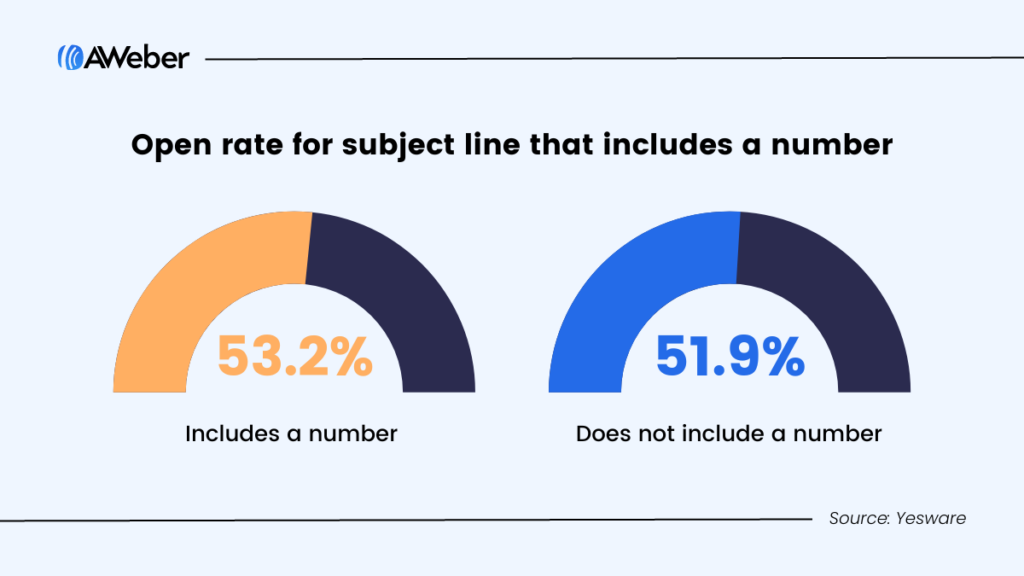
8 - Try a subject line generator
A subject line generator is a software that creates a subject line for you. These generators use artificial intelligence (or AI) to create subject lines based on answers you provide from a few simple questions such as: “What’s your email about?” and “What tone would you like to achieve?”
You’d be amazed at the quality of subject lines these AI-powered software can provide.
I recommend testing an AI-generated subject line versus one you create and see which one gets a higher open rate.
Related: 8 best email subject line generators
9 - Use one word subject lines
Another piece of advice from Copyhackers' Wiebe? Try one word subject lines.
Why? One word subject lines can be intriguing.
Here at AWeber, we've sent one word subject lines that wind up having a higher open rate than average.
10 - Or super long subject lines
Wait, didn't you just say try one word subject lines? Yes, yes I did.
But the reality is both really short and really long subject lines can work well. Ultimately, it's all about standing out and finding what works for your audience.
In fact, only 18% of people include more than 60 characters in their subject lines. So why not give it a go?
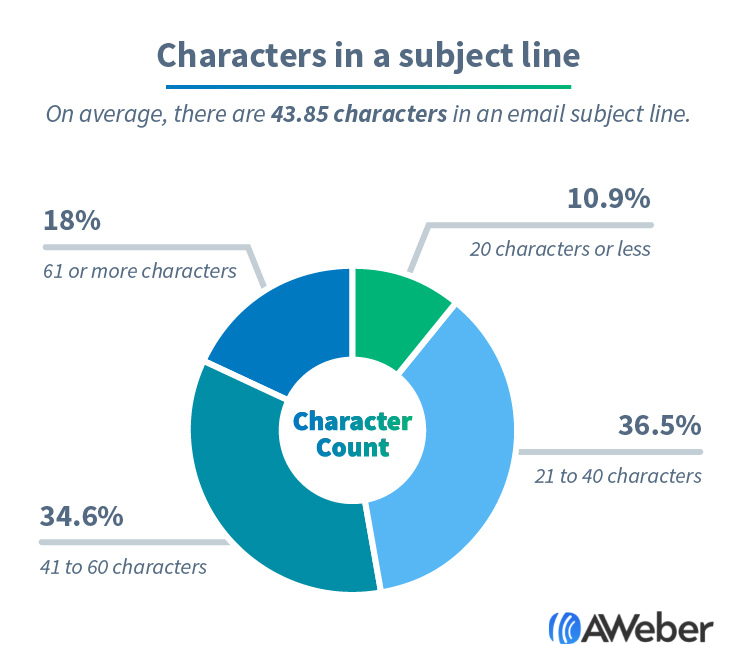
11 - Understand your audiences' pain points
Wiebe advises, "Put your audiences' pain points, fears or amazing outcomes in quotation marks and use the first person."
This formula could help your audience see themselves in your subject line. Because they feel aligned to the copy, they'll be more likely to open it to see what you have to say.
Again, this all goes back to knowing your audience. When you understand your audience — their hopes, dreams, fears, challenges and more — you can create copy that resonates with them and drives them to action. You have to include a value proposition that appeals to them.
As Wiebe says: "Because, of course, the copy in your subject line is only one small part of the equation when it comes to getting opens."
12 - Get personal
Alex Cattoni shares "The 3 P's" as a guide to write better subject lines. They are: personalization, provoke emotion, and getting personal.
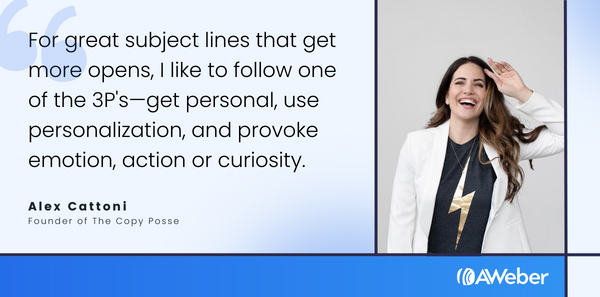
Let's talk about the latter.
"Get personal with a story-based subject line or a quick friendly greeting (i.e. I can't believe I just said that)."
- Alex Cattoni, Founder of The Copy Posse
Humans are drawn to stories. There's a reason so many childhood stories include life lessons — stories are how we remember important things and pass information on. So if you want to inspire your audience, hint at the story readers will find in your email through your subject line.
Plus, an intriguing subject line like the one Cattoni mentions above couldn't hurt get more opens.
13 - Provoke emotion, action or curiosity
Cattoni offers this example as a subject line to provoke emotion, action or curiosity: Is this freakishly accurate for you, too?
Would you open this email?
I would.
Because not only am I curious about what the author is experiencing, I want to know if it's something I am also encountering. I want to find out if we have shared experiences.
This subject line provokes curiosity and a desire for connection.
When writing a subject line like this, first think about what you want your reader to feel. Then, brainstorm questions to ask that would provoke that feeling.
Once you have a subject line written, get another opinion. Ask someone to read what you've written and tell you how it made them feel.
14 - AB test your subject lines
Subject lines are crucial because they are the very first thing people see in their inbox. If your subject line isn't interesting or relevant, your subscribers may never open your emails.
That's why split testing your subject lines is so important. With a simple split test, you can find out how to write more engaging subject lines that get opened.
There are a number of things you can split test in your subject line:
Length
Short subject line vs. long subject line? In general, you want to use the least number of characters possible while still getting your point across.
Sometimes you may find that it's more important to get your point across, and that requires a longer subject line.
Personalization
Should you use subscribers' names or other personal information in the subject? There are mixed reviews on personalization. It's up to you to find out how your subscribers feel about it.
Emojis
Should you include emojis in your subject line? Only one way to find out - test it.
Wording
How you say what you need to say is important.
For example, do subscribers like "% off" or "$ off?" Do they respond to psychological trigger words like "secrets?"
You can test these in your subject line to find what wording you should be using, and it can even help you with writing the rest of your messages.
Appearance
Your capitalization and punctuation can also influence subscribers. You don't want your subject line to look like spam, but at the same time you want it to pop. What you think looks good and what your subscribers think looks good can be different, so you need to test!
What email subject line best practices work for you?
Has something worked for you that we didn't share in this post? Comment below! We'd love to hear what works for you.
The post 14 Email subject line best practices to get more opens appeared first on AWeber.
from AWeber https://ift.tt/uAcOIBi
via IFTTT
No comments:
Post a Comment